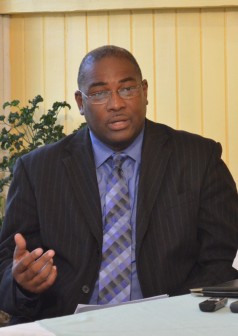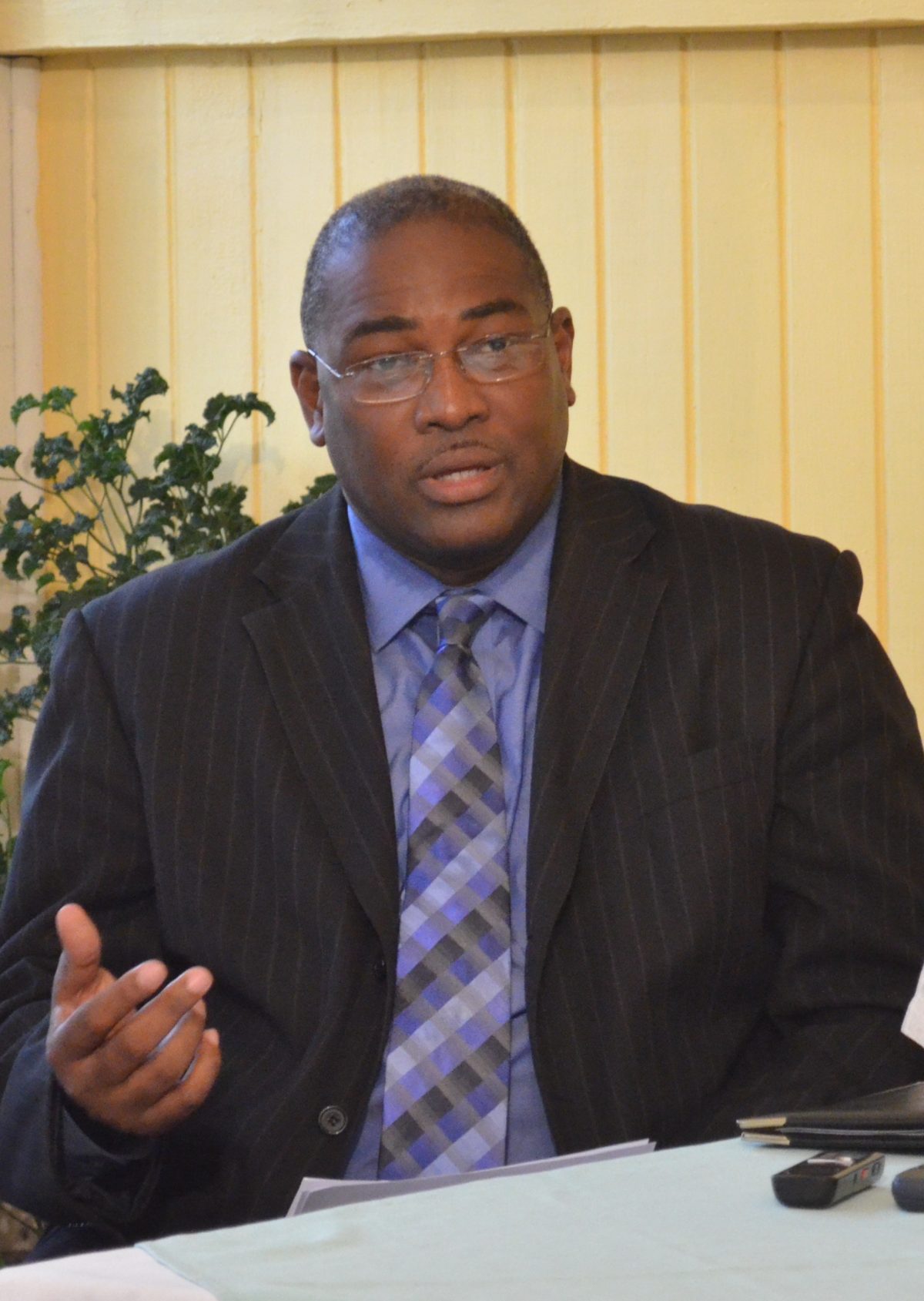Attorney Nigel Hughes today issued a statement on his withdrawal from the Linden Commission of Inquiry yesterday and in what would have likely been his closing statement to the probe declared that there was sufficient circumstantial evidence to show that the fatal firings on July 18 had been done by the police.
The statement follows:
Departure from the Linden Commission of Inquiry
On the 1st November 2012 I withdrew my appearance as representative of the relatives of the deceased at the Linden Commission of Inquiry. COI

My withdrawal was due solely to the fact that if I cannot ask questions or would be prevented from asking questions of witnesses then I cannot discharge my professional responsibilities to my clients.
My purpose and function would be reduced to that of a mere note taker.
In that capacity I would be unable to serve the interest of my clients.
The basis on which one assists one clients in a Commission of Inquiry is by questioning witnesses.
On the intervention of Commissioner Kennard, after the ruling of the chairman that I would not be permitted to ask questions without withdrawing or apologizing, Commissioner Kennard made it very clear on several occasions that he was speaking for himself.
The Chairman remained silent and the Commission’s position unchanged.
It has been brought to my attention that there have been claims by the Government media that (I) was unhappy with the way the Commission was proceeding. Nothing could be further from the truth
Permit me to set out below in a brief overview the relevant evidence which has been led before the Commission thus far
The circumstantial evidence that it was the Police who shot the three deceased and injured the Lindeners is compelling.
1. The deceased and injured were all shot with 00 pellets which were discharged from a 00 cartridge. The injured were in excess of 20 persons.
2. 2. The pellets could only have been discharged from a shot gun. Not a hand gun or rifle.
3. That eliminates the possibility of either a concealed weapon or sniper.
4. 3. A shot gun is at least three feet in length and hence would have been clearly visible at the time of the shooting.
5. 4. There were several hundred persons present at the time of the shooting and the only persons who were seen with shot guns were three police officers.
6. . Superintendent Todd, who was in charge, said that he discharged several rounds from shot guns which he took from various ranks who were on the police line in uniform.
7. 6. Todd further said that he was the only one who discharged the shot gun.
8. 7. No witness whether civilian or police claimed to have seen anyone else but the police armed with a shot gun.
9. The ballistic expert Dr. Robinson, testified that from the fact that the deceased died from single pellet shots meant they had to be in excess of 30 to 40 feet away from the shooter.
10. Todd’s testimony confirms that he was in excess of that distance when he fired the shot gun
11. Todd testified that he shot the ground in an attempt to cause the pellets to ricochet. The U.K. ballistic expert, the local ballistic expert and the police investigator who visited the scene the next morning all testified that there was no evidence of any ricochet on the ground or did the pellets show that they were fired ricochet.
12. . The position from which the persons were shot was consistent with the position where the police said they fired from.
13. 10. Todd admitted firing at least four times at the crowd yet no one in the crowd was injured with official # 04 and # 06 issued pellets. This would mean on Todd’s evidence they should all be buried in the ground (or) fell short of the crowd.
14. . The unaccounted gunman would have had to have fired repeatedly at the crowd and not be seen. Quite a feat.
15. The police claim that they heard four loud explosions coming from the bridge. Assuming for the purpose of argument that this was our missing shooter armed with a shot gun on the bridge then several people in the crowd on the bridge would have been shot.
16. The bridge was jammed pack so no space for 20 to 30 feet clear distance to allow a single shot to cause the death of protestors.
17. The only basis on which the police claim it is not their officers who killed the protestors is that they don’t issue 00 cartridges. This is the equivalent of a shooter standing over the body of a person who had just been shot and claiming that he did not shoot because he does not have the type of bullets which was found in the body of the deceased but his weapons is capable of firing that same type of bullet.
18. One of the police officers from Linden who was issued with a shot gun said he never knows what type of cartridges are issued to him when he uplifts his shot gun.
19. The ballistic results for the Linden weapons are not available. They were never sent to be tested.
What is circumstantial evidence.
Circumstantial evidence is “one strand of the cord might be insufficient to sustain the weight, but three stranded together may be quite of sufficient strength. Thus it may be in circumstantial evidence there may be a combination of circumstances, no one of which would raise a reasonable conviction, or more than a mere suspicion, but the whole, taken together, may create a strong conclusion of guilt, that is, with as much certainty as human affairs can require or admit.” from DPP V Kilbourne.
On the issue of Ministerial involvement in the events.
Don’t be distracted by the claim that the phone records don’t show contact before the shooting.
The following is the evidence.
1. Rohee testified that on the 17th July he had at least a 25 minute meeting with the COP, Persaud and Hicken at his office about the protest which was scheduled for the next day.
2. In his GINA interview on the 22nd July four days later, he said the issue of lethal force was discussed and he was given an undertaking that no lethal force would be used.
3. He further testified that he was given a briefing in which various scenarios were given but could not give details of any of the scenarios. He said only a general overview was given but could not remember any details.
4. He testified that he tried getting COP after the incident and he spoke with the COP but he could not get details of what transpired. He tried again could not get onto him that’s why he called Hicken six times, two hours later..
5. 4. The phone record reveals that he spoke with the COP for 1 second. It must have been quite an update in that second.
6. 5. After the shooting, Rohee admits in a GINA one on one interview on NCN, discussing the use of lethal force before the shooting with the COP, Seelall Persaud and Hicken.
7. He claims he got an undertaking that no lethal force would be used.
8. He further says in the interview that various scenarios were discussed.
9. So no issue that the use of lethal force was discussed by Rohee.
10. If lethal force was discussed, it had to be discussed in a particular context.
11. If he obtained an undertaking that lethal force would not be used then it means that either COP, Persaud or Hicken felt they had enough power to over ride the undertaking which was given to the Minister.
12. Which police officer in Guyana would authorise the use of lethal force in a charge political protest n the light of a clear prior undertaking to the Minister?
13. 6. Why wouldn’t the Minister on the first occasion ask who authorised the use of lethal force when he had been given a clear undertaking that it would not be used?
14. Rohee claims he ordered a report.
15. It is noteworthy that by the time of the GINA interview he was aware that lethal force had been used why on earth would Rohee at that time admit he was aware that the police would use lethal force. It would be admitting that he authorised the use of lethal force on innocent civilians during a protest by opposition supporters. Political suicide and potential criminal liability.
In short you have
(1) a discussion about the use of lethal force involving the Minister, COP, DCLE and Hicken in which he claims that he got an undertaking that lethal force would not be used.
(2) No evidence of any attempt to be briefed by COP after news of the shooting but a two hour delay before speaks with Hicken on five occasions but never asks who authorised the use of lethal force.
(3) A post fact admission of a discussion on the use of lethal force but a denial of any authorization.
So what does a discussion about the use of lethal force during a civil protest indicate?
Either it was authorised by the Minister or some police officer had enough balls to breach an undertaking to a minister.
Take your pick

